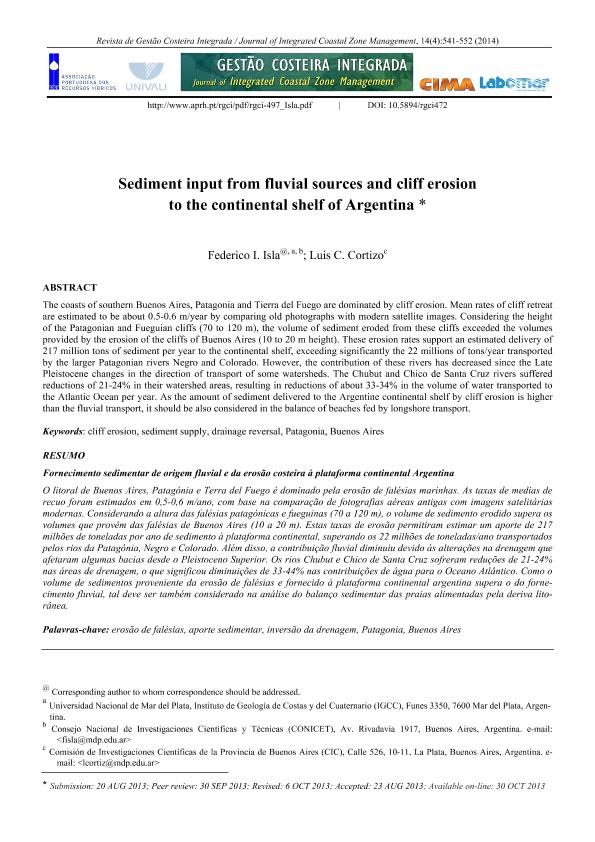Mostrar el registro sencillo del ítem
dc.contributor.author
Isla, Federico Ignacio

dc.contributor.author
Cortizo, Luis
dc.date.available
2018-01-31T19:44:03Z
dc.date.issued
2014-10
dc.identifier.citation
Isla, Federico Ignacio; Cortizo, Luis; Sediment input from fluvial sources and cliff erosion to the continental shelf of Argentina; Portuguese association of water resources; Journal of Integrated Coastal zone Management; 14; 4; 10-2014; 541-552
dc.identifier.issn
1646-8872
dc.identifier.uri
http://hdl.handle.net/11336/35290
dc.description.abstract
The coasts of southern Buenos Aires, Patagonia and Tierra del Fuego are dominated by cliff erosion. Mean rates of cliff retreat are estimated to be about 0.5-0.6 m/year by comparing old photographs with modern satellite images. Considering the height of the Patagonian and Fueguian cliffs (70 to 120 m), the volume of sediment eroded from these cliffs exceeded the volumes provided by the erosion of the cliffs of Buenos Aires (10 to 20 m height). These erosion rates support an estimated delivery of 217 million tons of sediment per year to the continental shelf, exceeding significantly the 22 millions of tons/year transported by the larger Patagonian rivers Negro and Colorado. However, the contribution of these rivers has decreased since the Late Pleistocene changes in the direction of transport of some watersheds. The Chubut and Chico de Santa Cruz rivers suffered reductions of 21-24% in their watershed areas, resulting in reductions of about 33-34% in the volume of water transported to the Atlantic Ocean per year. As the amount of sediment delivered to the Argentine continental shelf by cliff erosion is higher than the fluvial transport, it should be also considered in the balance of beaches fed by longshore transport.
dc.description.abstract
O litoral de Buenos Aires, Patagónia e Terra del Fuego é dominado pela erosão de falésias marinhas. As taxas de medias de recuo foram estimados em 0,5-0,6 m/ano, com base na comparação de fotografias aéreas antigas com imagens satelitárias modernas. Considerando a altura das falésias patagónicas e fueguinas (70 a 120 m), o volume de sedimento erodido supera os volumes que provêm das falésias de Buenos Aires (10 a 20 m). Estas taxas de erosão permitiram estimar um aporte de 217 milhões de toneladas por ano de sedimento à plataforma continental, superando os 22 milhões de toneladas/ano transportados pelos rios da Patagónia, Negro e Colorado. Além disso, a contribuição fluvial diminuiu devido às alterações na drenagem que afetaram algumas bacias desde o Pleistoceno Superior. Os rios Chubut e Chico de Santa Cruz sofreram reduções de 21-24% nas áreas de drenagem, o que significou diminuções de 33-44% nas contribuições de água para o Oceano Atlântico. Como o volume de sedimentos proveniente da erosão de falésias e fornecido à plataforma continental argentina supera o do fornecimento fluvial, tal deve ser também considerado na análise do balanço sedimentar das praias alimentadas pela deriva litorânea.
dc.format
application/pdf
dc.language.iso
eng
dc.publisher
Portuguese association of water resources
dc.rights
info:eu-repo/semantics/openAccess
dc.rights.uri
https://creativecommons.org/licenses/by-nc-sa/2.5/ar/
dc.subject
Cliff Erosion
dc.subject
Sediment Supply
dc.subject
Drainage Reversals
dc.subject
Patagonia
dc.subject
Buenos Aires
dc.subject.classification
Meteorología y Ciencias Atmosféricas

dc.subject.classification
Ciencias de la Tierra y relacionadas con el Medio Ambiente

dc.subject.classification
CIENCIAS NATURALES Y EXACTAS

dc.title
Sediment input from fluvial sources and cliff erosion to the continental shelf of Argentina
dc.title
Fornecimento sedimentar de origem fluvial e da erosão costeira à plataforma continental Argentina
dc.type
info:eu-repo/semantics/article
dc.type
info:ar-repo/semantics/artículo
dc.type
info:eu-repo/semantics/publishedVersion
dc.date.updated
2018-01-26T18:56:30Z
dc.journal.volume
14
dc.journal.number
4
dc.journal.pagination
541-552
dc.journal.pais
Portugal

dc.journal.ciudad
Lisboa
dc.description.fil
Fil: Isla, Federico Ignacio. Consejo Nacional de Investigaciones Científicas y Técnicas; Argentina. Universidad Nacional de Mar del Plata. Facultad de Ciencias Exactas y Naturales. Instituto de Geología de Costas y del Cuaternario. Provincia de Buenos Aires. Gobernación. Comisión de Investigaciones Científicas. Instituto de Geología de Costas y del Cuaternario; Argentina
dc.description.fil
Fil: Cortizo, Luis. Provincia de Buenos Aires. Gobernación. Comisión de Investigaciones Científicas; Argentina
dc.journal.title
Journal of Integrated Coastal zone Management
dc.relation.alternativeid
info:eu-repo/semantics/altIdentifier/doi/http://dx.doi.org/10.5894/rgci436
dc.relation.alternativeid
info:eu-repo/semantics/altIdentifier/url/http://www.aprh.pt/rgci/rgci436.html
Archivos asociados
